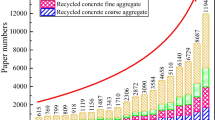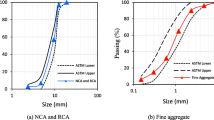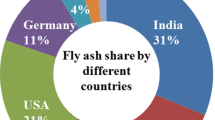Abstract
The drastic surge in urbanisation and construction-related activities is increasing the demand for cement and aggregates, especially for concrete production. Concrete is utilised for a wide variety of structural applications, including rigid pavements construction, due to its superior strength and durability performance. However, the production of cement increases carbon footprint; and the source of natural aggregates depletes. Hence, there is an increased demand for pavement designs that incorporate sustainable materials and maintain a consistent level of service. In rigid pavements construction, this can be achieved with the integration of alternate binder systems, such as paper mill ash (PMA). This paper presents a systematic review of the engineering properties of PMA as a partial cement replacement material for sustainable concrete production. The review is focused on the influence of PMA on the engineering properties of concrete. The main advantages and limitation of using PMA were highlighted and discussed. Grey areas for possible research exploit were also identified. Based on the superior tensile strength (2.68–3.98 MPa) and flexural strength (4.04–5.01 MPa) documented in the various works of literature reviewed, it can be concluded that PMA is a feasible alternative binder material for rigid pavement applications. This, coupled with its negligible CO2e emission value, indicate that PMA is beneficial to the sustainability and serviceability states of rigid pavements. The viewpoint of this review will be useful for researchers and stakeholders in the construction industry to acquire more understanding of PMA concrete.
Similar content being viewed by others
References
Tamanna K, Raman SN, Jamil M, Hamid R (2020) Utilisation of wood waste ash in construction technology: a review. Constr Build Mater 237:117654
Schneider M (2019) The cement industry on the way to a low-carbon future. Cem Concr Res 124:105792
Doudart de la Grée GCH, Yu QL, Brouwers HJH (2018) Upgrading and evaluation of waste paper sludge ash in eco-lightweight cement composites. J Mater Civ Eng 30(3):04018021
Singh NB, Middendorf B (2020) Geopolymers as an alternative to Portland cement: an overview. Constr Build Mater 237:117455
Plati C (2019) Sustainability factors in pavement materials, design, and preservation strategies: a literature review. Constr Build Mater 211:539–555
Poongodi, K., Murthi, P., Awoyera, P. O., Gobinath, R., & Olalusi, O. B. (2020). Durability properties of self-compacting concrete made with recycled aggregate. Silicon, 1-9. https://doi.org/10.1007/s12633-020-00635-7
Di Mascio P, Loprencipe G, Moretti L (2019) Technical and economic criteria to select pavement surfaces of port handling plants. Coatings 9(2):126
Pandey A, Kumar B (2020) A comprehensive investigation on application of microsilica and rice straw ash in rigid pavement. Constr Build Mater 252:119053
Jiao, X. (2013). Comparison of fuel consumption on rigid versus flexible pavements along I-95 in Florida
South African National Roads Agency Ltd (SANRAL) (2020). [online] Nra.co.za. Available at: https://www.nra.co.za/live/content.php?Item_ID=279 [Accessed 15 Jan. 2020]
South African Engineering Pavement Engineering Manual (SAPEM). (2013). Chapter 2: Pavement composition and behaviour. South African National Roads Agency Ltd (SANRAL)
Anderson SD, Ullman GL, Blaschke BC (2002) A process for selecting strategies for rehabilitation of rigid pavements. Texas Transportation Institute, Texas A&M University, College Station, Texas
Murthi P, Poongodi K, Awoyera PO, Gobinath R, Raja KT, Olalusi OB (2020) Fresh properties of self-compacting concrete incorporating electric arc furnace oxidising slag (EAFOS) as coarse aggregate. SN Applied Sciences 2(4):1–8. https://doi.org/10.1007/s42452-020-2497-6
Thangapandi K, Anuradha R, Awoyera PO, Gobinath R, Archana N, Berlin M, Oladimeji OB (2020) Durability phenomenon in manufactured sand concrete: effects of zinc oxide and Alcofine on behaviour. Silicon. https://doi.org/10.1007/s12633-020-00494-2
Kumar, K. R., Shyamala, G., Awoyera, P. O., Vedhasakthi, K., & Olalusi, O. B. (2020). Cleaner production of self-compacting concrete with selected industrial rejects-an overview. Silicon, 1-12. https://doi.org/10.1007/s12633-020-00636-6
Environmental Paper Network. (2018). The State of the Global Paper Industry
PAMSA. (2018). South African pulp and paper industry – summary of 2018 production, import and export statistics. Paper manufacturers Association of South Africa (PAMSA)
FP&M SETA. (2014). A profile of the paper and pulp sub-sector. Paper and Pulp Sector
Fava G, Ruello M, Corinaldesi V (2011) Paper mill sludge ash as supplementary Cementitious material. J Mater Civ Eng 23(6):772–776
Bai J, Chaipanich A, Kinuthia JM, O’Farrell M, Sabir BB, Wild S, Lewis MH (2003) Compressive strength and hydration of wastepaper sludge ash-ground granulated blastfurnace slag blended pastes. Cem Concr Res 33(8):1189–1202
Kumar A, Rani D (2016) Performance of concrete using paper sludge ash and foundry sand. International Journal of Innovative Research in Science, Engineering and Technology 5:171–176
Mavroulidou, M., Boulouki, G. and Unsworth, C. (2013). Incorporating waste paper sludge ash as partial cement replacement in concrete. In: 13th international conference of environmental science and technology
Sharipudin S, Ridzuan ARM (2012) Influence of waste paper sludge ash (WPSA) and fine recycled concrete aggregate (FRCA) on the compressive strength characteristic of foamed concrete. Adv Mater Res 626:376–380
Sudha JL, Sagar DSVSR, Ram RJ (2018) Experimental studies on strength characteristics of concrete with waste paper sludge ash as partial replacement for cement. International Journal of Research and Analytical Reviews (IJRAR) 5(4):342–347
Vegas, I., Urreta, J., Frías, M., Rodríguez, O., Ferreiro, S., Nebreda, B., García, R. and Vigil, R. (2009). Engineering properties of cement mortars containing thermally activated paper sludge. In: 7th international conference on sustainable Management of Waste and Recycled Materials in construction, pp.225–232
Ahmad S, Iqbal Malik M, Bashir Wani M, Ahmad R (2013) Study of concrete involving use of waste paper sludge ash as partial replacement of cement. IOSR Journal of Engineering 3(11):06–15
Gailius A, Laurikietytė Ž (2003) Waste paper sludge ash and ground granulated blast furnace slag as binder in concrete. J Civ Eng Manag 9(3):198–202
Dunster, A.M. (2007). Paper sludge and paper sludge ash in Portland cement manufacture. MinRes Case Study, Building Research Establishment, Garston
Likon, M. and Trebše, P. (2012). Recent advances in paper mill sludge management. Industrial waste, pp.73-90
Mabee W, Roy DN (2003) Modeling the role of papermill sludge in the organic carbon cycle of paper products. Environ Rev 11(1):1–16
Furlani E, Brückner S, Minichelli D, Maschio S (2008) Synthesis and characterisation of ceramics from coal fly ash and incinerated paper mill sludge. Ceram Int 34(8):2137–2142
Bujulu, P.M.S., Sorta, A.R., Priol, G. and Emdal, A.J. (2007). Potential of wastepaper sludge ash to replace cement in deep stabilisation of quick clay. In: 2007 Annual conference of the transportation Association of Canada, Saskatoon, Saskatchewan
Elliott A, Mahmood T (2006) Beneficial uses of pulp and paper power boiler ash residues. TAPPI J 5(10):9–16
Wong HS, Barakat R, Alhilali A, Saleh M, Cheeseman CR (2015) Hydrophobic concrete using waste paper sludge ash. Cem Concr Res 70:9–20
Bin Mohd Sani, M.S.H., Bt Muftah, F. and Ab Rahman, M. (2011). Properties of Waste Paper Sludge Ash (WPSA) as Cement Replacement in Mortar to Support Green Technology Material. In: 3rd International Symposium & Exhibition in Sustainable Energy & Environment, pp.94–99
Ferrándiz-Mas V, Bond T, García-Alcocel E, Cheeseman CR (2014) Lightweight mortars containing expanded polystyrene and paper sludge ash. Constr Build Mater 61:285–292
Frías M, García R, Vigil R, Ferreiro S (2008) Calcination of art paper sludge waste for the use as a supplementary cementing material. Appl Clay Sci 42(1–2):189–193
García R, Vigil de la Villa R, Vegas I, Frías M, Sánchez de Rojas MI (2008) The pozzolanic properties of paper sludge waste. Constr Build Mater 22(7):1484–1490
Pera J, Amrouz A (1998) Development of highly reactive Metakaolin from paper sludge. Adv Cem Based Mater 7(2):49–56
Vegas I, Frías M, Urreta J, San José JT (2006) Obtaining a pozzolanic addition from the controlled calcination of paper mill sludge. Performance in cement matrices. Mater Constr 56(283):49–60
García Giménez, R., Vigil De La Villa, R., Goñi, S. and Frías, M. (2015). Fly ash and paper sludge on the evolution of ternary blended cements: Mineralogy and hydrated phases. Journal of Materials in Civil Engineering, 27(9), p.04014249
Mozaffari E, O’Farrell M, Kinuthia JM, Wild S (2006) Improving strength development of wastepaper sludge ash by wet-milling. Cem Concr Compos 28(2):144–152
ASTM. (2008). Standard specification for coal fly ash and raw or calcined natural pozzolan for use in concrete. C618, west Conshohocken, PA
Poojitha B, Bhanu Pravallika S (2017) Study on partial replacement of cement with waste paper sludge ash in fibre reinforced concrete. International Journal of Engineering Science and Computing (IJESC) 7(5):11329–11335
Mozaffari E, Kinuthia JM, Bai J, Wild S (2009) An investigation into the strength development of wastepaper sludge ash blended with ground granulated Blastfurnace slag. Cem Concr Res 39(10):942–949
Kinuthia, J.M., O’Farrell, M., Sabir, B.B. and Wild, S. (2001). A preliminary study of the cementitious properties of wastepaper sludge ash – ground granulated blastfurnace slag (WSA-GGBS) blends. In: recovery and recycling of paper: proceedings of the international symposium organised by the concrete technology unit and held at the University of Dundee, Scotland, UK on 19 march 2001 (p. 93). Thomas Telford
Veerappan, G., Kinuthia, J.M., O’Farrell, M., Sabir, B.B. and Wild, S. (2003). Compressive strength of concrete blocks manufactured using wastepaper sludge ash. Recycling and reuse of waste materials, pp.563-575
Chaipanich, A., Bai, J., O’Farrell, M., Kinuthia, J.M., Sabir, B.B. and Wild, S. (2005). Setting time and heat of hydration of wastepaper sludge ash-ground granulated blastfurnace slag blended cements. In: cement combinations for durable concrete: proceedings of the international conference held at the University of Dundee, Scotland, UK on 5-7 July 2005, pp.825-834. Thomas Telford publishing
Vigil de la Villa R, Frías M, Sánchez de Rojas M, Vegas I, García R (2007) Mineralogical and morphological changes of calcined paper sludge at different temperatures and retention in furnace. Appl Clay Sci 36(4):279–286
Zhang Z, Scherer GW, Bauer A (2018) Morphology of cementitious material during early hydration. Cem Concr Res 107:85–100
Segui, P., Aubert, J.E. and Husson, B. (2011). Characterisation of wastepaper sludge ash for its use as component for hydraulic binders. In: Innovation & Valorisation in Civil Engineering & Construction Materials (INVACO2), Rabat, Morroco
Segui P, Aubert JE, Husson B, Measson M (2012) Characterisation of wastepaper sludge as for its valorisation as a component of hydraulic binders. Appl Clay Sci 57:79–85
Segui P, Aubert JE, Husson B, Measson M (2012) Valorisation of wastepaper sludge ash as Main component of hydraulic road binder. Waste and Biomass Valorisation 4(2):297–307
Pachamuthu S, Thangaraju P (2017) Effect of incinerated paper sludge ash on fly ash-based geopolymer concrete. Journal of the Croatian Association of Civil Engineers 69(9):851–859
Monosi S, Sani D, Ruello ML (2012) Reuse of paper mill ash in plaster blends. The Open Waste Management Journal 5(1):5–10
Goñi S, Frías M, Vegas I, García R, Vigil de la Villa R (2012) Effect of ternary cements containing thermally activated paper sludge and fly ash on the texture of C-S-H gel. Constr Build Mater 30:381–388
Wu H, Huang B, Shu X, Yin J (2016) Utilisation of solid wastes/byproducts from paper mills in controlled low strength material (CLSM). Constr Build Mater 118:155–163
Frías M, Sánchez de Rojas MI, Rodríguez O, García Giménez R, Vigil de la Villa R (2008) Characterisation of calcined paper sludge as an environmentally friendly source of metakaolin for manufacture of cementitious materials. Adv Cem Res 20(1):23–30
Doudart de la Grée G.C.H., Yu, Q.L. and Brouwers, H.J.H. (2018). Upgrading and Evaluation of Waste Paper Sludge Ash in Eco-Lightweight Cement Composites. Journal of Materials in Civil Engineering, 30(3), p.04018021
Aini, N.S., Haniff, M.A., Fadzil, M.A., Ridzuan, A.R.M. and Halim, A.A. (2013). Effect of WPSA particle size to the morphology and compressive strength properties of hydrated cement paste contain WPSA as SCM. In: 2013 IEEE business Engineering and industrial applications colloquium (BEIAC), pp.301-305
Abdul Ghani AH, Fadzil Arshad M, Salehuddin NA, Ridzuan ARM (2015) Hydration kinetics and strength development of waste paper sludge ash (WPSA) with different particle size as binary blended cement. Appl Mech Mater 754-755:382–388
Owens G (2013) Fundamentals of concrete3rd edn. The Concrete Institute, Midrand
Gavrilescu D (2008) Energy from biomass in pulp and paper mills. Environ Eng Manag J 7(5):537–546
Babalola OE, Awoyera PO, Tran MT, Le DH, Olalusi OB, Viloria A, Ovallos-Gazabon D (2020) Mechanical and durability properties of recycled aggregate concrete with ternary binder system and optimised mix proportion. Journal of Materials Research and Technology 9:6521–6532. https://doi.org/10.1016/j.jmrt.2020.04.038
Jarnerud, T. (2019). Utilisation of recovered lime-containing materials from pulp and paper industries as slag formers in stainless steel production (Doctoral dissertation, KTH Royal Institute of Technology)
South African Engineering Pavement Engineering Manual (SAPEM). (2013). Chapter 9: materials utilisation and design. South African National Roads Agency Ltd (SANRAL)
Babafemi, A., Savija, B., Paul, S.C. and Anggraini, V. (2018). Engineering properties of concrete with waste recycled plastic: a review. Sustainability, 10(11), p.3875
Ayub T, Khan SU, Memon FA (2014) Mechanical characteristics of hardened concrete with different mineral admixtures: a review. Sci World J 2014:1–15
Mohammed BS, Fang OC (2011) Mechanical and durability properties of concretes containing paper-mill residuals and fly ash. Constr Build Mater 25(2):717–725
Koratich, D. (2020). Drying shrinkage. [online] Engr.psu.edu. Available at: <https://www.engr.psu.edu/ce/courses/ce584/concrete/library/cracking/dryshrinkage/dryingshrinkage.html.[accessed 23 march 2020]
Saleh, A. (2008). Chloride induced corrosion and Sulphate attack – a literature review on concrete durability
Funding
No funding was received.
Author information
Authors and Affiliations
Corresponding author
Ethics declarations
Conflict of Interest
The authors declare that they have no conflict of interest.
Additional information
Publisher’s Note
Springer Nature remains neutral with regard to jurisdictional claims in published maps and institutional affiliations.
Rights and permissions
About this article
Cite this article
Pillay, D.L., Olalusi, O.B. & Mostafa, M.M. A Review of the Engineering Properties of Concrete with Paper Mill Waste Ash — Towards Sustainable Rigid Pavement Construction. Silicon 13, 3191–3207 (2021). https://doi.org/10.1007/s12633-020-00664-2
Received:
Accepted:
Published:
Issue Date:
DOI: https://doi.org/10.1007/s12633-020-00664-2




